 Para Para
Para Paraby Andy Seto
ComicsOne, $13.95
With
Para Para, crator Andy Seto has now firmly established himself on my list of favorite artists.
I have
previously praised Seto's abilities to represent the furious motion of cinematic martial arts on the static printed page in his adaptation of
Crouching Tiger, Hidden Dragon. In
Para Para, he goes one step further by representing a singing and dancing movie musical so effectvely you can practically hear the music swelling and see the characters dancing.
The story in
Para Para is a variation on the classic Romeo and Juliet story (in fact, several of the secondary characters in the comic comment on the resemblance), as rich girl Yuki falls for gangster Dennis. their romance swirls around Para Para, a dance craze that is also one of those electronic dancing arcade games. It's a story that's complete in this one volume, which doesn't give a lot of time to explore the characters in depth. But that's fine, as the real purpose of the plot is to give the characters an excuse to break out in song and/or dance at various opportunities.
It's the song and dance sections that give
Para Para its strength. Seto is at the very top of his game here. Witness the opening scene: as autumn leaves fall, we see various young people milling about, with close-ups of the Para Para logo on their clothing. The word 'Dance' appears as a bright red sound effect. There's a voice-over going on, which we realize is probably meant to be song lyrics, and the 'camera' focuses on one of these young people, identified as Dennnis Lingmu, obviously caught up in the music and dancing. The camera then pulls back, and we see a chorus of dancers has formed behind Dennis ina two-page spread. Turn the page, and in another two-page spread the camera has pulled back further: we see that the dancers are in a large courtyard, with a large office building on one sid, an elevated train track on the other, a city and mountains in the background, and a large clocktower in the the foreground on the right chiming away. Turn the page again and Dennis's song concludes over the image of orange leaves falling against a stark white background. The title
Para Para floats over the leaves, while a giant leaf in the bottom right is superimposed with the face of Yuki, her eyes pensively looking to the right and up, leading us visually to the top of the next page, where the next scene fades in with Yuki at swimming practice.
It's a stunning scene, expertly rendered. And there are several more just like it throughout. The scene where Yuki and Dennis first meet is on a rainy Hong Kong street: the color has been completely leached out of the background, leaving it in stark black and white, while Yuki and Dennis appear in color, and Yuiki has one of those soul-bearing songs that seem to happen frequently in musicals. Of course, this being a dance musical, there are a couple of dance contests, which Seto depicts such that you can practically feel the rhythm of the music as you watch the characters move across the pages.
Yes, the plot isn't terribly deep and the emotion sometimes runs to hysteric heights, but this is a musical created for the comics page.
Para Para wins in presenting a dynamic example of comics artistry and, despite the tragic ending (it is loosely based on
Romeo & Juliet after all) is still a joyful comics experience.
Rating: 4 (of 5)
 Over in this thread on the TCJ message boards someone has posted scans of a short story from a 70's-era Creepy magazine. The story is a triffle, totally ripping off an old Twilight Zone, but the art, by Carmine Infantino & Alex Toth, is just amazing. Toth's inks are rather overwhelming, but it really works. I'm reminded of how great these old masters were, and how much better a lot of the stuff from that era looks in black and white, instead of suffering under the horrible coloring technology of the day.
Over in this thread on the TCJ message boards someone has posted scans of a short story from a 70's-era Creepy magazine. The story is a triffle, totally ripping off an old Twilight Zone, but the art, by Carmine Infantino & Alex Toth, is just amazing. Toth's inks are rather overwhelming, but it really works. I'm reminded of how great these old masters were, and how much better a lot of the stuff from that era looks in black and white, instead of suffering under the horrible coloring technology of the day.